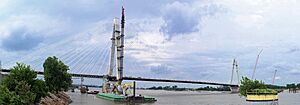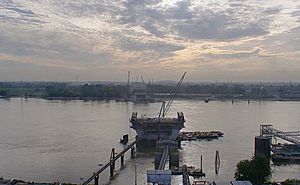Stan Musial Veterans Memorial Bridge facts for kids
Quick facts for kids Stan Musial Veterans Memorial Bridge |
|
|---|---|

Stan Musial Veterans Memorial Bridge as seen from the Big Mound.
|
|
| Coordinates | 38°38′40″N 90°10′42″W / 38.64444°N 90.17833°W |
| Carries | 4 lanes of |
| Crosses | Mississippi River |
| Locale | St. Louis, Missouri and St. Clair County, Illinois |
| Official name | Stan Musial Veterans Memorial Bridge |
| Maintained by | Missouri Department of Transportation |
| Characteristics | |
| Design | Cable-stayed bridge |
| Total length | 2,803 feet (854 m) |
| Width | 102 feet (31 m) |
| Longest span | 1,500 feet (457 m) |
| Clearance below | 75 feet (23 m) |
| History | |
| Designer | HNTB Corporation |
| Construction cost | $695 mil. |
| Opened | February 9, 2014 12:00 p.m. |
| Inaugurated | February 8, 2014 |
| Statistics | |
| Daily traffic | 53,700 cars and trucks |
The Stan Musial Veterans Memorial Bridge is a large bridge that crosses the Mississippi River. It connects St. Clair County, Illinois, with St. Louis, Missouri. People sometimes called it the "New Mississippi River Bridge" or "Stan Span" before it got its official name.
Building the bridge started in April 2010 and finished in July 2013. It officially opened to cars and trucks on February 9, 2014. This bridge is a cable-stayed bridge, which means its deck is supported by strong cables connected to tall towers. Its main part stretches 1,500 feet (457 meters) across the river.
Contents
Bridge Design and Size
The main part of the bridge is 1,500 feet (457 meters) long. The total length of the bridge is 2,803 feet (854 meters). It is 86 feet (26 meters) wide.
The bridge has two tall, A-shaped towers. These towers reach 435 feet (133 meters) above the highway below. The main part of the bridge is held up by many strong cables. These cables use enough wire to stretch almost two times from St. Louis to Chicago!
Workers used nearly 15,000 tons of structural steel and 8,600 tons of reinforcing steel to build the bridge. They also used a lot of concrete for the foundation, the road, and the towers. When it was finished, this bridge was the third-longest cable-stayed bridge in the United States.
Traffic Flow
The Stan Musial Veterans Memorial Bridge was built to help reduce traffic on other bridges nearby. It was also designed to handle more cars in the future. The bridge currently has four lanes for traffic, but it can be expanded to six lanes later on. It was also designed so that another bridge could be built right next to it if needed.
When the bridge first opened, it was expected to carry about 40,000 cars and trucks each day. After three months, about 31,000 vehicles were using it daily. However, after three and a half years, the daily traffic increased to 53,700 vehicles!
The new bridge helped reduce traffic on other bridges:
- Traffic on the Martin Luther King Bridge went down by 44%.
- The Eads Bridge saw 3,000 fewer cars per day.
- The Poplar Street Bridge, which is usually the busiest, had 20,000 fewer cars per day.
Road Changes
When the new bridge opened, the route for Interstate 70 (I-70) was changed. I-70 now uses the Stan Musial Veterans Memorial Bridge to cross the river. The older part of I-70 that went through downtown St. Louis became Interstate 44. The Poplar Street Bridge still carries traffic for I-55, I-64, and US 40.
How the Bridge Was Paid For
Budget and Costs
The first plan for the bridge and the roads around it was going to cost almost $1.7 billion. That was too expensive for the states of Illinois and Missouri. So, they came up with a new, smaller design in 2007 that would cost about $667 million.
Of that money, $264 million was for moving I-70 in Illinois, $57 million for moving I-70 in Missouri, and $346 million for building the bridge itself. Illinois planned to pay $313 million, and Missouri planned to pay $115 million. A special grant from the federal government covered the remaining $239 million. The final cost of the bridge ended up being $695 million.
No Tolls
At one point, there was a discussion about making the bridge a "toll bridge." This would mean drivers would have to pay money to cross it. Some officials in Missouri thought about letting a private company build and run the bridge, and that company would collect tolls for up to 99 years.
However, officials in Illinois and many lawmakers from St. Louis wanted the bridge to be free to cross. In 2008, the governors of Missouri and Illinois signed an agreement that the bridge would not have tolls.
Construction Bids
The cost to build just the main part of the bridge was first thought to be around $190 million. But the actual bids were higher. A group of construction companies won the contract to build the main span for $229.5 million.
Building the Bridge
Before building started, engineers studied the ground under the river. They found thick layers of loose sand. This kind of sand could become unstable during an earthquake. To make the bridge safe, they decided to use very deep foundations. They drilled large piers, 12 feet (3.7 meters) wide and 120 feet (37 meters) long, down into the solid limestone bedrock. This bedrock is about 120 feet (37 meters) deep on the Illinois side and 30 to 60 feet (9 to 18 meters) deep on the Missouri side.
Naming the Bridge
The bridge's name was a big topic of discussion for many years.
In 2004, some members of the Veterans of Foreign Wars collected over 4,000 signatures to name the bridge the "Veterans Memorial Bridge." There was already another Veterans Memorial Bridge over the Missouri River, and the Martin Luther King Bridge was once called "Veterans Memorial Bridge" before it was renamed.
In 2005, the Missouri State Legislature voted to name the bridge after President Ronald Reagan.
In 2011, there was a proposal to name it the "Jerry F. Costello–William Lacy 'Bill' Clay Sr. Veterans Memorial Bridge" after two important politicians. But this idea was later rejected. Some groups also suggested naming it the "Women Veterans Memorial Bridge."
Finally, on January 22, 2013, a lawmaker suggested naming the bridge after Stan Musial. Stan Musial was a very famous baseball player for the St. Louis Cardinals who had recently passed away. This idea needed to be approved by lawmakers in both Illinois and Missouri.
The two states agreed! The bridge was officially named the Stan Musial Veterans Memorial Bridge. President Barack Obama signed the bill to make it official on July 12, 2013. An important part of the Missouri approach to the bridge was also named the Andy Gammon Memorial Highway, in honor of a bridge worker who died during the construction.
Images for kids





